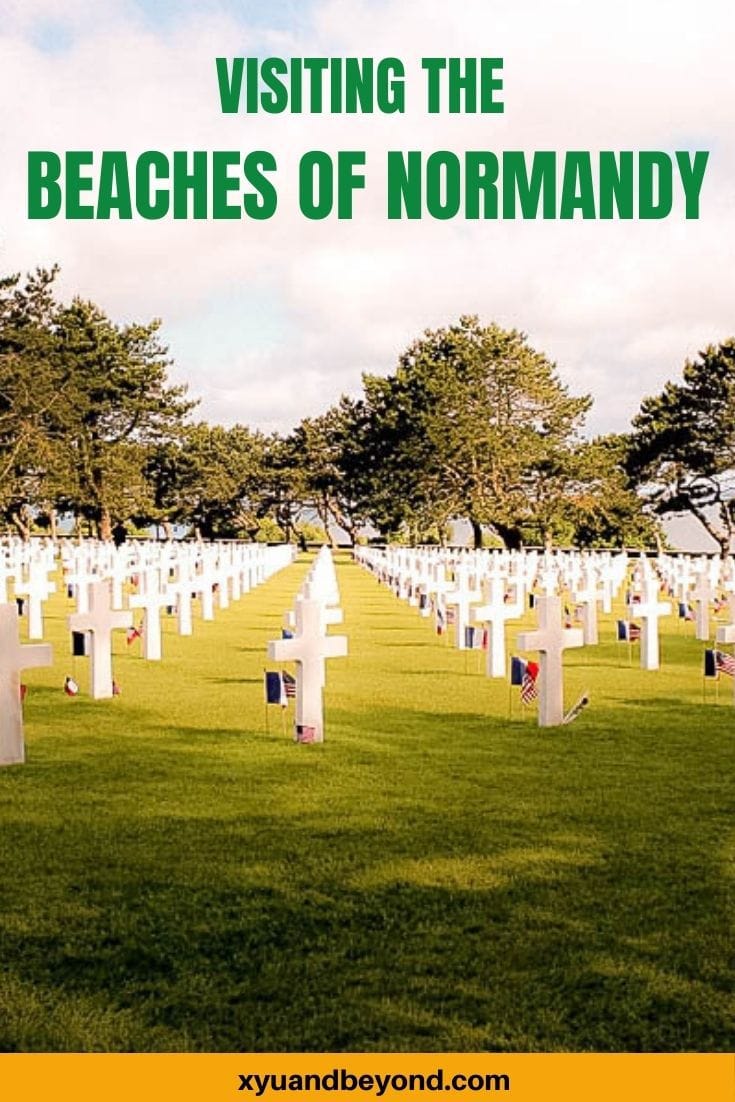Normandy Landings: Visiting the D-Day landing beaches
The Normandy battle sites are a poignant reminder of one of the most significant events in modern history: the Allied amphibious invasion of German-occupied France on June 6, 1944. Known as D-Day. The Normany Beaches were chosen as the were not as heavily defended as other areas. This operation marked a turning point in World War II and ultimately led to the defeat of Nazi Germany and was the largest amphibious invastion in the history of warfare.
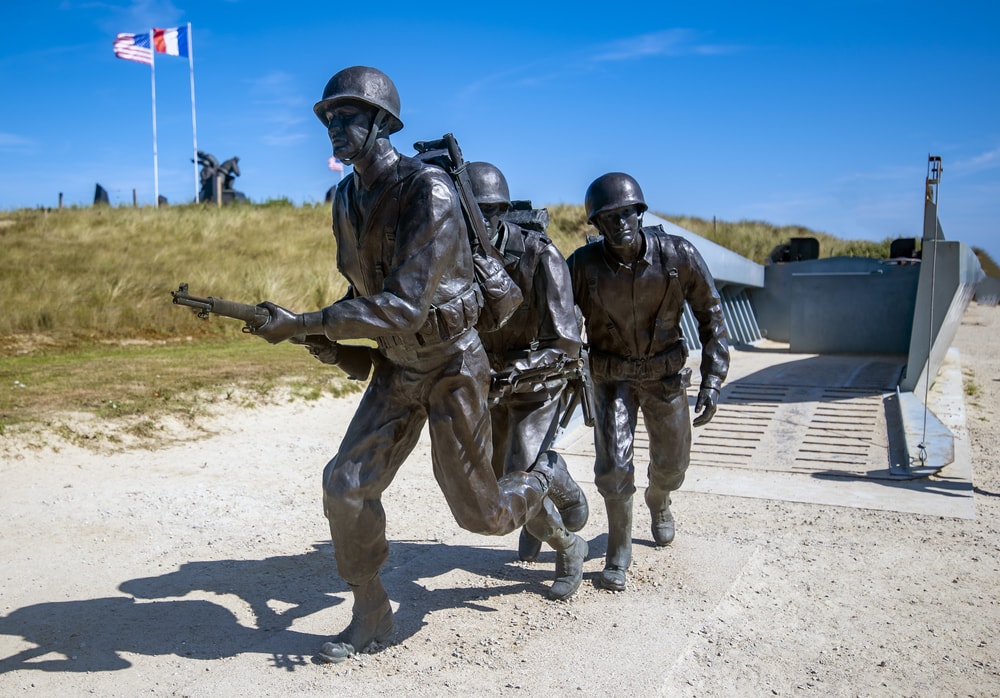
Today, visitors to Normandy can explore the main D-Day Landing beaches and towns where these momentous battles took place, paying tribute to the bravery and sacrifice of those who fought for freedom. From Omaha Beach to Sainte-Mère-Église, each site offers a unique perspective on this pivotal moment in human history.
2023 will be the 79th year of memorials to D-Day in Normandy France. June 6, 1944. Since any and all commemorative events were cancelled in 2020 there is hope that the country will be honouring those who fought in 1944 will be able to be properly honoured this year. The beaches of Normandy will once again be a place of tribute and remembrance.
2024 will see the 80th anniversary of D-Day. This major event will once again bring many Heads of State together in ceremonies paying homage to the last surviving veterans of all nationalities

It is difficult at this time to tell what D-Day memorials will be going ahead but we do know that D-day Museums, memorials and all sites should be opened from May 19th (fingers crossed). You can visit the beaches of Normandy at any time even if the museums and memorials are closed.
Before the world closed down Normandy was one of the most visited places in France during the month of June. Naturally, most tourists divided their time between a visit to Paris and other locations such as Provence but many American tourists specifically come to France to pay their respects to family members who fought and those who died on the Normandy Beaches during WWII.
Frequently Asked Questions about the Landing Beaches of Normandy
What are the Landing Beaches of Normandy?
The landing beaches of Normandy refer to the coastal areas in northwestern France where the D-Day landings took place on June 6, 1944 during World War II. These beaches were the key points for the Allied invasion of German-occupied France.

How many beaches were involved in the D-Day landing?
The D-Day landing consisted of five main beaches, codenamed Omaha, Utah, Gold, Juno, and Sword beaches, each designated for specific Allied forces to land and secure.
What role did airborne troops play in the Normandy landing?
Airborne troops played a critical role in the Normandy landing by parachuting or gliding behind enemy lines to secure key objectives and disrupt German defenses before the amphibious landings took place.
Which beach saw the fiercest resistance during the D-Day landings?
Omaha Beach witnessed some of the fiercest resistance during the D-Day landings due to its high cliffs, strong defenses, and heavily fortified German positions, resulting in a high number of casualties among the Allied forces.
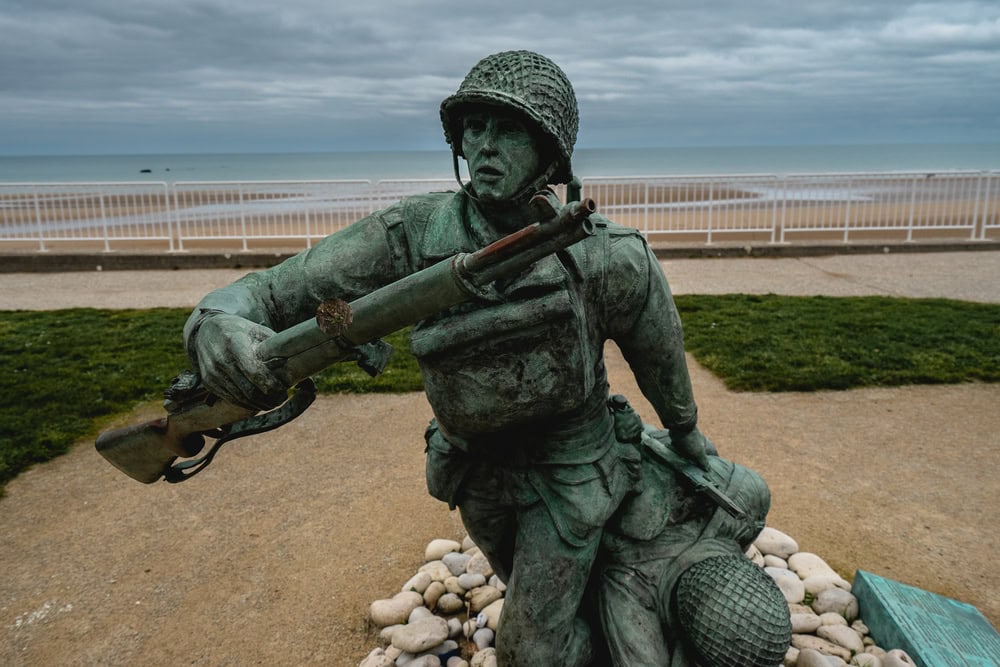
What was the significance of the Normandy landing in World War II?
The Normandy landing marked the beginning of the end for Nazi Germany in World War II, leading to the liberation of France and the eventual defeat of the Axis powers in Europe.
How did the Allies prepare for the D-Day invasion?
The Allied forces meticulously planned the D-Day invasion through Operation Overlord, which involved extensive training, intelligence gathering, naval bombardment, and deception tactics to ensure the success of the largest amphibious operation in history.
Where can visitors pay tribute to the fallen soldiers of the Normandy landing?
Visitors can pay tribute to the fallen at any of the cemetaries slightly inland from the beaches.
Here’s a little background information about Normandy if you want to visit here.
Map of the D-Day Landing Beaches of Normandy

You can download a copy of the map here.
- Normandy Landings: Visiting the D-Day landing beaches
- Frequently Asked Questions about the Landing Beaches of Normandy
- What are the Landing Beaches of Normandy?
- How many beaches were involved in the D-Day landing?
- What role did airborne troops play in the Normandy landing?
- Which beach saw the fiercest resistance during the D-Day landings?
- What was the significance of the Normandy landing in World War II?
- How did the Allies prepare for the D-Day invasion?
- Where can visitors pay tribute to the fallen soldiers of the Normandy landing?
- Map of the D-Day Landing Beaches of Normandy
- Where is Normandy in France?
- Getting to Normandy from Paris
- A brief history of Normandy
- Bletchley Park – Alan Turing & D-day
- Normandy Battle Sites
- The D-Day Landing Sites and Memorials
- Memorial Museum of the Battle of Normandy
- Things to see and do in the Canadian Juno sector
- Sword Beach
- Omaha Beach
- Normandy Beaches tours
- The Caen Memorial
- Frequently Asked Questions about the Landing Beaches of Normandy
Xyuandbeyond is reader-supported. When you buy through links on our site, we may earn an affiliate commission. You can read my privacy policy here.
Where is Normandy in France?
The Normandy region is on the northern coast of France and borders the Ile de France, which is the Paris region Most visitors to Normandy fly into Paris Charles de Gaulle Airport and travel the short distance to Normandy. The drive from the airport to cities like Dieppe or Caen in Normandy is around 2.5 to 3 hours.
Getting to Normandy from Paris
Getting from Paris to Normandy couldn’t be simpler. The trains from Gare Saint Lazare are an easy 2-hour ride from Paris to Bayeux or Caen. Depending on the time of day, there are direct trains or routes with an easy-to-navigate connection through Caen.
If coming from the UK or Ireland you can simply take a ferry across the channel. There are overnight ferries from both the UK and Ireland depending on which port you leave from.
Catching the ferry to Normandy is easy from the UK you can sail to Normandy from Newhaven to Dieppe or come into the ports of Caen, Cherbourg and Le Havre.

A brief history of Normandy
Normandy is simply full of history and one of the great regions of France going back beyond the Middle Ages. Normandy was one of the great dukedoms which rivalled the prestige and power of any in France. The Dukes of Normandy had the same status as the Kings of France to whom they pledged their allegiance. When the King of England Edward the Confessor (he was the last Anglo-Saxon King of England) died without an heir he named his nephew William Duke of Normandy as his successor.
This wasn’t welcomed by Harold who took the crown for himself and as a result, William invaded England in 1066 during the great battle of Hastings Harold was killed and William regained the Crown. The story of Harold and William the Conquerer as he became known is told in the Bayeux Tapestry which can be seen in Bayeux a few miles west of Caen.
Bletchley Park – Alan Turing & D-day
Bletchley Park had been compiling vital intelligence for Allied commanders for over 18 months in the run-up to D-Day, but the Codebreakers also supported the operation as it unfolded.
Notably, around the date of the storming of the beaches in Normandy (May-July 1944), Bletchley Park took the risk of intercepting enemy messages directly on-site in order to speed up the codebreaking process. Secret listeners in Hut 18 were monitoring German Enigma traffic round the clock to monitor the response to the invasion, as well as any threats to the invasion fleet at sea, and the movement of troops in northern France – so that nothing was left to chance. By D-Day, the 7,000-strong workforce at Bletchley Park was decrypting almost 5,000 Enigma messages a day.
Normandy Battle Sites
D-Day and the Battle of Normandy were predominantly fought in the areas of Calvados, Manche and Orne, and it is here that you will find the many memorials, cemeteries and museums that commemorate what happened.
The D-Day Landing Beaches extend over 70km from Sainte-Marie-du-Mont to Ouistreham, via Colleville-sur-Mer and Arromanches-les-Bains.
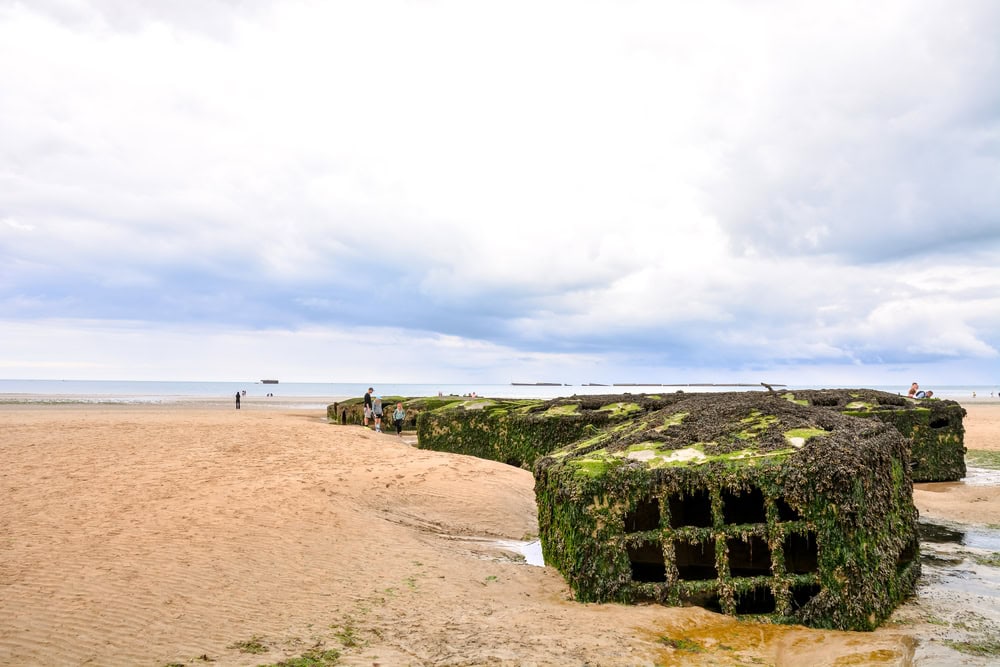
Operation Fortitude
German preparations along the Atlantic Wall were only partially finished; shortly before D-Day Rommel reported that construction was only 18 per cent complete in some areas as resources were diverted elsewhere. Operation Fortitude was the code name for a World War II military deception by the Allied nations as part of an overall strategy with the Code name Bodyguard during the build-up to the Normandy landings.

These days on the Normandy D-Day beaches you will hear the laughter of children and see tourists and locals alike enjoying the watersports and enjoying some of Normandy’s delicious cuisine with a glass or two of Calvados a fine Cider or wine. But never forget that the opportunity for you to visit here was due to those who sacrificed their lives and those who lived on to remind us of this immense undertaking.
We owe who and what we are as a nation, as Canadian, American, or European that those that fought and died for our freedoms are worthy of great respect and honouring their legacies.
Nearly 3,000 Allied servicemen, mostly soldiers, lost their lives on D-Day. Every year, millions come to see where and how the conflict took place. The D-Day Landing Beaches have since become a symbol of the price of peace across the world.
The D-Day Landing Sites and Memorials
What were the Operation Overlord beach names? The operation, given the codename OVERLORD, delivered five naval assault divisions to the beaches of Normandy, France. The beaches were given the code names UTAH, OMAHA, GOLD, JUNO, and SWORD.
Musee de la Reddition
One of the most important WWII sites in Normandy may also be among the least-known – the Musée de la Reddition (Capitulations Museum) in Reims, France. In a humble brick school building, you can find this small museum where, in the middle of a fateful May night, German General Jodl signed the first papers of surrender, ending the six-year war.
The building was originally used as the Allied Expeditionary Force in Europe headquarters, which was led by General Dwight D. Eisenhower. There were two surrender signings – the first ceremony took place here, in Reims, and the second in Berlin.

At the Musée de la Reddition, you will relive the days and nights that led up to the first surrender. See the written postcards, tattered uniforms, original press reports, and other artefacts from the role of the city of Reims in WWII.
The museum visit begins with a brief screening of a movie to catch you up on your WWII history before you enter the exhibition area, which culminates in the ‘signing room’ aka the ‘war room.’ The short film is sufficient to stir emotions and sets the tone for the rest of the experience.

Entrance is €5 for full-priced tickets, with discounts available for certain demographics.
Musée de la Reddition is on Bus 4 route (Roosevelt stop) or Tram A route (Schneiter stop). It is within walking distance of the train station. Contributed by Jade The Migrant Yogi.
Pegasus Bridge Memorial
The British 6th Airborne Division, on the eastern flank, was assigned to capture intact the bridges over the Caen Canal and River Orne, destroy five bridges over the Dives 6 miles (9.7 km) to the east, and destroy the Merville Gun Battery overlooking Sword Beach.
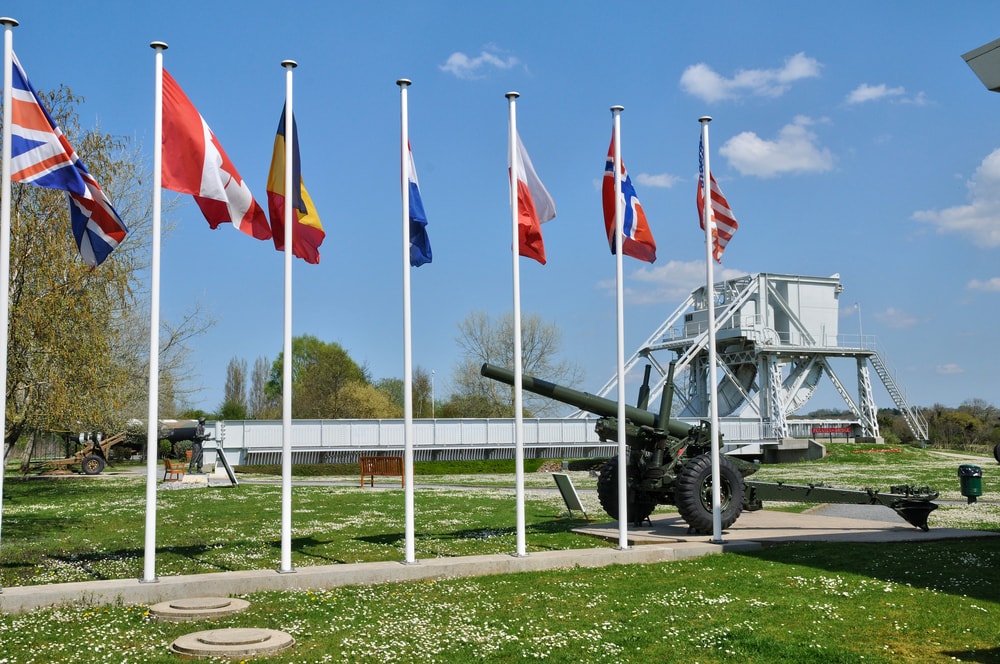
The Pegasus Memorial Museum, near Caen, tells the story of when the very first liberators from the British 6th Airborne Division landed on Norman soil on the night of the 5th to the 6th of June 1944. Period documents, films and objects. Guided tours of the museum, of Pegasus Bridge and of the reproduction of a WWII glider. Guided tour in French or English lasts 1h30.
Gold Beach and British Normandy Memorial
The 50th Infantry Division was to be the main division to land at Gold Beach on D-Day, 6 June 1944. The troops landed on Gold Beach and communicated with the Canadian troops who had landed at Juno Beach. Luckily for the British, there were no German armoured divisions on the beach and what was there was rendered ineffective by the bombings of the evening before.
Casualties had been minimal and out of 25,000 men that landed and penetrated 6 miles inland 400 casualties had been suffered by the time the troops entered Bayeux towards the evening.
Arromanches-les-Bains in World War II
Sitting at the heart of the Gold Beach Landing Zone is Arromanches-les-Bains. Peppered with Normandy WW2 memorial memorials and WWII gift shops Arromanches is an easily walkable charming little village.
Here you can see the remains of the mulberries in the harbour, check out the Musée du Débarquement, or watch an immersive theatre experience at Arromanches 360°.
Arromanches-les-Bains
Travelling around northern France, one of our main goals was to visit the World War II sites. The one that struck us the most was Normandy Beach.
The day we went to Normandy Beach was windy and chilly, but that didn’t stop the many beach-goers who were sunbathing and playing on the sand. Families had their picnic baskets and umbrellas, and they were there for a day of fun in the sun.

Most of the visitors didn’t give the huge hunks of metal stacked upon and near the beach much attention. That’s where the tourists and the beach-goers differed. The chunks of metal are remnants of Mulberry Harbors or “Mulberries,” for short. They are temporary harbours allowing supplies to be brought to the shores of France.
After the success of Operation Overlord, conquering the beaches of Normandy, two Mulberries were assembled. Each Mulberry consisted of 73 heavy blocks tied together to support a roadway for the trucks and troops to work on. It was thanks to these harbours that the Allied troops were allowed to continue fighting after the initial invasion.
The hulls of the Mulberries are a stark reminder that June 6, 1944, and Operation Overlord, was a turning point in the war. On any given day, walking down Normandy Beach between the scrap hulls is a haunting experience. You can almost hear the cries and shouts of the men working to resupply the soldiers in the field through the echoes of the seagulls above. Corinne Vail of Reflections Enroute
Memorial Museum of the Battle of Normandy
The Normandy D-Day Museum is located at the gateway to the D-Day beaches, the Memorial Museum of the Battle of Normandy is the only museum that presents all of the military operations which took place on Norman soil over the summer months of 1944.
The Bayeux War Cemetery
Located near the museum, the British military cemetery contains over 4,648 graves of Commonwealth soldiers killed during the Second World War. 338 of them are unidentified and 500 are of other nationalities, mainly German. The Bayeux Memorial stands opposite the cemetery and on it are written the names of over 1800 men who died in the early stages of the landing and have no grave.

Utah Beach
Stretching from Sainte-Marie-du-Mont to Quinéville, Utah beach was key to the American’s re-taking of Cherbourg. It was assaulted on June 6, 1944, by the U.S. 4th Infantry Division and was taken with relatively few casualties. Utah Beach was the westernmost beach of the five landing areas in Normandy and not on the original plan for D-Day. It was General Eisenhower who added it to the assault to ensure Cherbourg’s capture.
The Utah attack was the deadliest beach on D-Day and it went disastrously wrong initially as the strong currents made landing difficult and the smoke from the shore bombardment obscured the landing areas. Three of the four landing craft were lost to mines but the remaining control craft managed to round up the others and using a bullhorn led them in.
The Utah Beach landings may have begun badly but ended up a spectacular success. Due to landing in a less defended section of the beach over 20,000 troops and 1700 vehicles managed to land with fewer than 300 casualties.
Sainte-Mere-Eglise is the ideal starting point to discover the landing beaches and particularly Utah Beach in Sainte-Marie du Mont. Located ten miles from Carentan, it still bears traces of the Battle of Normandy, and more specifically of the Normandy landings. With Utah Beach, Sainte-Mere-Eglise was one of two areas where airborne operations were conducted. The Allied forces of the 82nd and 101st Airborne Divisions landed around Sainte-Mère-Eglise on 5th June 1944.
Airborne Museum – Sainte-Mere-Eglise
The Airborne Museum first opened its doors back in 1962, in the centre of Sainte-Mère-Eglise. It takes visitors into the very heart of the fighting by the US paratroopers of the 82nd and 101st Airborne Divisions in the early hours of June 6th 1944.
Unique of its kind in Europe, it features a life-sized scene depicting a stick of paratroopers belonging to the 506th Parachute Infantry Regiment of the US 101st Airborne Division enplaning at an English aerodrome in June 1944.
Sainte-Mère-Église Church in Angoulême
While visiting Normandy’s beaches is one of the most popular activities to do here, visiting the tiny church of Sainte-Mere-Eglise also makes a memorable experience, too. This tiny one-room 11th-century church in a Norman village lay right in the crosshairs of the German resistance to the American 82nd and 101st Airborne Division paratroopers who landed nearby on D-Day…far from the planned drop zone on the beaches.

The 101st Airborne (or “Screaming Eagles”, as they were better known) requisitioned the church to care for the wounded. The Red Cross flew a flag, signalling to all that it was a safe zone. And just like that, wounded Germans and Americans alike—80 in all—were cared for together here in this tiny church in the midst of one of the bloodiest battles in history. Despite the fact that the two medics had just two months of training between them and had never seen a battle before, they lost just two of their charges.
Today, at Saint-Mere-Eglise, you can see a beautiful stained glass window that pays homage to the 101st Airborne as well as a memorial just outside. May the world never forget the sacrifice made by so many. Contributed by Chris at Explore Now or Never.
The story of John Steele
John Steele was from Illinois and he parachuted into Saint-Mere-Eglise on the eve of D-Day. His parachute caught on the Church steeple He hung there for two hours, pretending to be dead before the Germans took him, prisoner. Steele later escaped from the Germans and rejoined his division when US troops of the 3rd Battalion, 505 Parachute Infantry Regiment attacked the village, capturing thirty Germans and killing another eleven. The incident was portrayed in the movie The Longest Day by actor Red Buttons.
To this day in the village, John Steele is commemorated with a replica of him and his parachute hanging from the Church’s steeple. There’s also an inn in the village that bears his name “l’Auberge John Steele, just next door to the church.
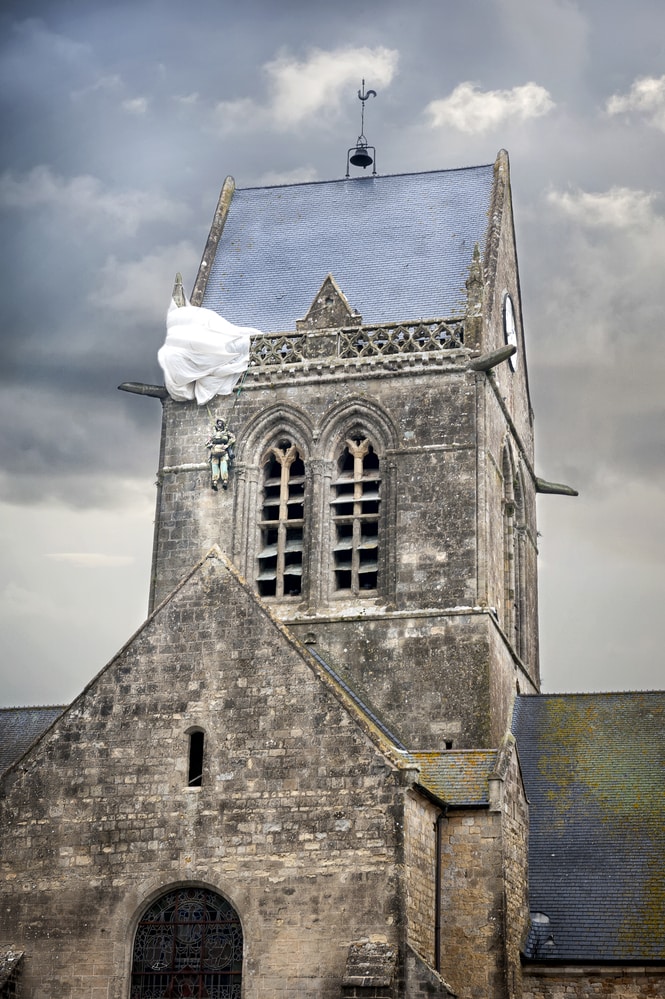
Juno Beach
Juno Beach was targeted for the Canadian assault on D-Day. The 3rd Infantry Division and 2nd Armoured Brigade seized the beach and the nearby villages all while under intense fire. Heavy casualties were taken by the 3rd Infantry but they took control of the beach by the end of the day.
Choppy waters caused a delay in the landing, and the high tide made the beach narrower, causing a traffic jam with vehicles and equipment. Juno beach had strong defenses, leading to high casualties among the first wave of infantry. By midnight, the Canadians had not yet met up with the British forces at Sword beach, but they had secured exits from the beach, moved inland for several miles, and eventually linked up with the British at Gold beach.
More than 14,000 Canadian soldiers and 6400 British Troops landed or parachuted into France on D-Day. The Royal Canadian Navy contributed 110 warships and 10,000 sailors and the RCAF contributed 15 fighter and fighter-bomber squadrons to the assault. There were 1,074 Canadian casualties, including 359 killed.
Pointe du Hoc
Between Omaha Beach and Utah Beach, the Pointe du Hoc is one of the essential places to visit on the landing beaches in Normandy.
A strategic point on the Atlantic Wall, the Pointe du Hoc site was stormed on the morning of June 6, 1944 by Colonel Rudder’s Rangers. It was one of the most difficult battles of the landing: in the end, of the 225 Rangers, only 90 of them were still in a condition to continue the liberation.
Things to see and do in the Canadian Juno sector
Bény-sur-Mer Canadian War Cemetery
On D-Day alone, Canada suffered almost a thousand casualties, of whom 340 were killed or died of wounds. The list lengthened during the following days as the Germans fought desperately to drive the Allies out.
The men who fell on the beaches and in the Normandy battles of Juno are buried in Beny-sur-Mer the Canadian War Cemetery which, is near the village of Reviers. The cemetery contains 2,049 headstones enclosed by pines and maples. These mark the dead of the 3rd Division and the graves of 15 airmen.
The mayor and people of Reviers take a special interest in the cemetery for, although it bears another name, they feel it to be their own. Meticulously maintained the cemetery is edged by manicured hedges and the registry building has platforms from which you can see the whole area and pay your respects to the dead.
The Juno Beach Centre
The Juno Beach Centre is the only Canadian museum on the D-Day Beaches. The museum presents the civilian and military war effort in Canada and on various fronts during the Second World War.
The Centre pays homage to the 45,000 Canadians who lost their lives during the War, of which 5,500 were killed during the Battle of Normandy and 359 on D-Day. Opened in 2003 by veterans and volunteers with a vision to create a permanent memorial to all Canadians who served during the Second World War, the Centre’s mandate is to preserve this legacy for future generations through education and remembrance.

Sword Beach
Sword Beach, the easternmost beach of the five landings and the juncture of all major roads in the area that ran through Caen, and was a key city to both the Allies and the Germans for transportation and manoeuvre purposes. It was assaulted by units of the British 3rd Division, with French and British commandos attached. Shortly after midnight on D-Day morning, using gliders the Airborne Divisions seized the inland bridges and took out the German artillery that was threatening the landing forces.
British War Cemetery
This small British War Cemetery contains those who fell at Sword Beach and is located near Caen at Douvres-la-Délivrande. It is one of the 17 British war cemeteries in Calvados.
The cemetery contains 923 British graves, 180 German graves, 11 Canadian graves, 3 Australian graves, 1 Polish grave of an unknown soldier. The majority of the soldiers interred in the cemetery were killed on D-Day, 6 June 1944 and the following weeks as the Allies advanced south towards Caen. There are a number of burials of soldiers killed on Sword Beach.

Omaha Beach
Two-thirds of the seaborne troops from the United States on D-Day were launched against this 4 miles long beach. The American 29th Infantry and the 1st Infantry Divisions were badly attacked in this assault. There were mines, barbed wires and concrete fortifications along the beach and many men were lost on what became known as “Bloody Omaha”. The troops were on their own after a hard-fought battle against waves and tides to get to the beach and destroyed craft, vehicles and bodies littered the beach.
Eventually, navy destroyers moved in and almost beaching themselves they started bombarding the German troops point-blank while the troops scaled the cliffs to take out the German fortifications. The sheer persistence and stubbornness of the assault forces eventually won the day and the Germans surrendered. The Americans suffered 2,400 casualties at Omaha on June 6, but by the end of the day, they had landed 34,000 troops.
Omaha Beach Memorial Museum
For more than 25 years, the museum in Saint-Laurent-sur-Mer has paid tribute to the soldiers who landed on the Normandy Beaches. The Museum showcases chronologically the events from the German occupation to the American landing on Omaha Beach.

Normandy American Cemetery
Above the cliffs of Ohama Beach, overlooking the English Channel is the largest beach and most violent battle of the D-Day landings lay the resting places of the Americans who fought there.
Normandy American Cemetery looks exactly the opposite of what happened below its bluff on June 6, 1944; it is serene, spotless, and beautiful.
Cemeteries are typically monuments that evoke sadness, and while that is still an ever-present emotion when visiting Normandy American Cemetery, the feelings that overwhelm you the most are those of hope and pride.

It is a visceral experience to walk the pristine grounds and notice the care put into preserving the lives of the people who were part of this war.
The sea of marble headstones glistens bright white representing over 9,000 American soldiers, in the shape of a cross for Catholics and Protestants, and in a Star of David for those of Jewish faith.
For those soldiers who were never found, there is the Wall of the Missing, created to commemorate their courage and remember their lives.

Be sure to take a moment to visit the Memorial, an amphitheatre-like monument with grand stone columns. Along the walls of the structure are maps of operations and battles that took place to make you understand the history these people lived.
Admire the peaceful reflection pool in front of the Memorial before making your way to visit the Chapel and stand beneath its rotunda.
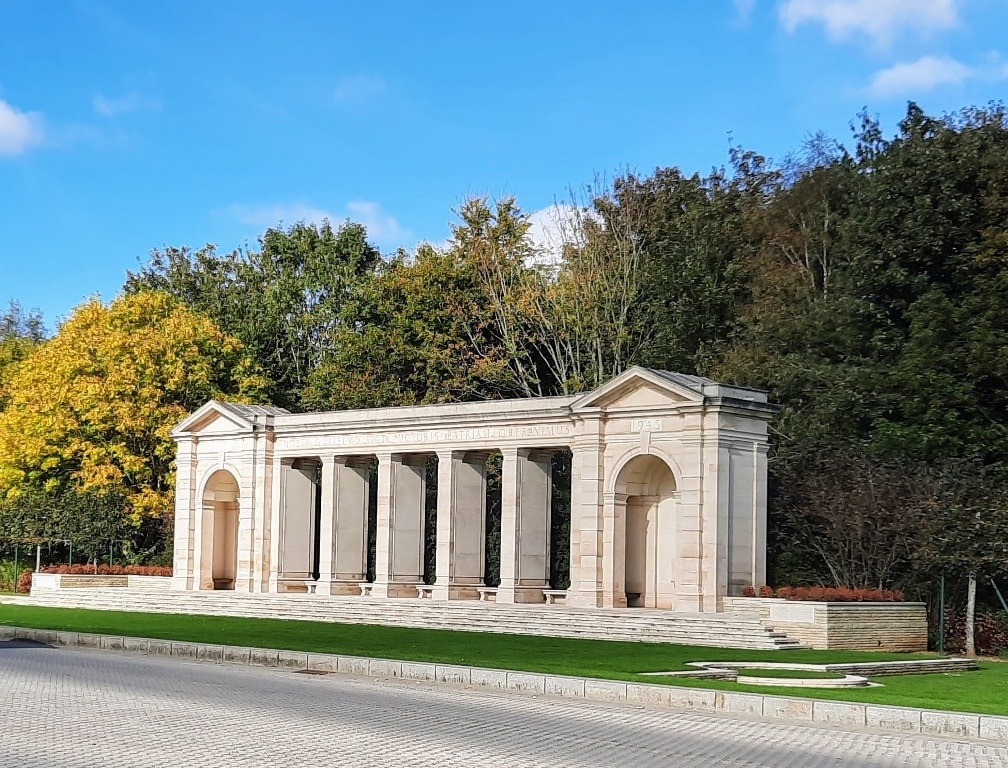
Normandy American Cemetery, overall, is one of the best places to visit in Normandy. No matter your background or beliefs, it is a spiritual experience that allows you to feel closer to history and gain a deeper understanding of the lives affected by and lost during World War II. Contributed by Michela from She Goes the Distance.
La Cambe German War Cemetery
During your trip through Normandy, you will see many American, Canadian and French flags everywhere. But what about the fallen Germans in this area?
Indeed, the Nazis were the bad guys in the horror movie called World War II. And while their troops included young radicals devoted to Hitler, it is also known that many of those who went to the front lines to fight were often the most “innocent”. Someone’s sons and brothers, are trained to obey the orders of their superiors without questioning the cause or motivations.
The German war cemetery of La Cambe is located near Omaha, one of the beaches where the landing of American soldiers took place. It has been in operation since 1948 and contains some 21,000 graves of German soldiers who died during the war. It is striking how dark the plaques and crosses on the graves are. This is the result of the Versailles peace treaty of 1919, from which the German cemeteries outside the country would maintain that sobriety.

The place is quiet. As soon as you enter the cemetery, you will see in the distance a grassy mound with a large cross on top and two figures of soldiers on each side. It is the mass grave where some 250 unknown soldiers are buried. Then, on the grass, you will walk among the slabs corresponding to each grave where sets of 5 stone crosses are scattered. One of the most sought-after tombs among visitors is the one of the tank commander Michael Wittmann, recognized for being one of the best in his field during the war.

Undoubtedly, together with the cemetery of the United States, this German cemetery is worth a visit to know the whole story. Flor Vallejo of Travel Ruta del Mate
The American Cemetery at Colleville-sur-Mer
One of the most poignant World War II memorial sites in Normandy is the Normandy American Cemetery and Memorial at Colleville-sur-Mer, 22 kilometres from Bayeux.
The cemetery, which overlooks Omaha Beach and covers just over 172 acres, is the final resting place for thousands of military personnel, most of whom lost their lives in the D-Day Landings.
With 9,385 graves at the site, the sheer number of headstones is heart-wrenching. Each of the headstones is marked with either a white cross or a white Star of David, as well as the name of the soldier that is buried within.
Wandering amongst the headstones that stretch as far as the eye can see, and reading the names of those who lost their lives fighting for our freedom, you can’t help but be moved to tears.

In addition to the graves, the names of a further 1,557 soldiers whose remains had not been identified or recovered by the end of the war, are featured on the Walls of the Missing. The soldiers whose remains have since been identified now have their names marked with a rosette.
There is also a small chapel and memorial set amongst the gardens and a visitor centre which contains interactive displays, exhibits and film, honouring the thousands of Americans who are buried so far from home.

The Normandy American Cemetery and Memorial receive around one million visitors per year and is open daily except for Christmas Day and New Year’s Day. Entry is free. Contributed by Carolyn of Holidays to Europe.
Overlord Museum – Omaha Beach
Located at the roundabout leading to the Normandy American Cemetery near Omaha Beach, the Overlord Museum boasts a unique collection of over 10,000 exhibits, including 35 vehicles, tanks and guns.

Normandy Beaches tours
There are many Normandy Beach tours available from various areas of France and depending on your interests they can range from touring Canadian D-Day sites to American D-Day sites.
The Caen Memorial
If you are interested in World War 2, and more particularly in the D-day events in Normandy, the Caen Memorial Museum is an excellent introduction to the topic. Caen, one of the main cities in Normandy, is one of the easiest day trips from Paris thanks to direct and fast train connections. It is possible to visit the Caen Memorial Museum on a day trip from Paris or – even better – as part of a Normandy road trip.
This ‘museum for peace’ hosts a comprehensive collection of items and documents related to the landings on the beaches in Normandy on 6 June 1944.
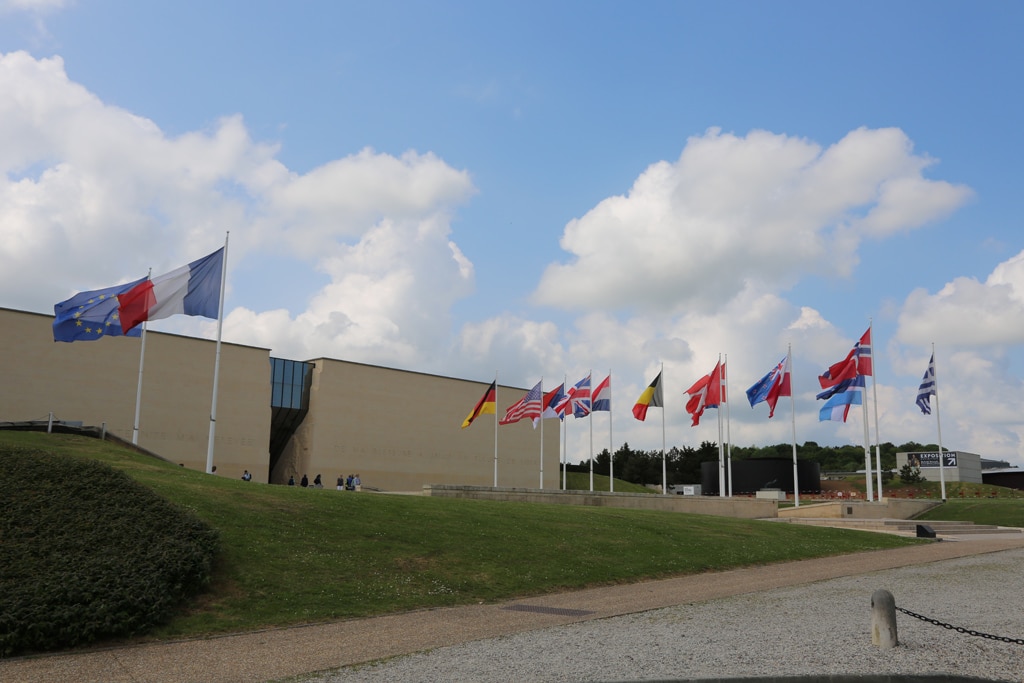
With the museum ticket, visitors also have access to a documentary about the D-day. This short film is very interesting to watch because of the importance of the events for our history, but also heartbreaking.
At the back of the museum, there are beautiful gardens that are perfect for a stroll in the fresh air after the documentary. An external staircase connects the museum with General Richter’s command bunker. Here, visitors can see how was the life of the Nazi soldiers during the conflict through information panels and the reconstruction of scenes with historical objects and mannequins.
The memorial also has an on-site restaurant, which is the usual place where guided tours do the lunch break. Contributed by Elisa of World in Paris.
This is in no way a definitive guide to the beaches of Normandy and the Normandy Invasion or the many museums and sites along the WWII routes of the area. These are just a few of the places that others who have visited recommend you see along the way. I’ve been to Auschwitz-Birkenau in Poland and had family members fight in WWII and as someone who understands the sacrifices my grandparents and parents made to keep the world safe, I believe these types of memorial sites should be on everyone’s bucket list.
You might also be interested in
A soul-disturbing Visit to Auschwitz from Krakow
Bletchley Park Museum home of the Codebreakers
Pin it to save it


